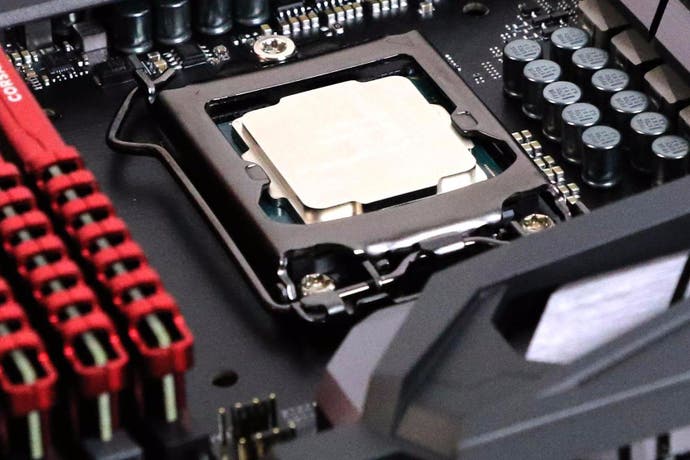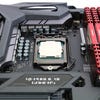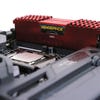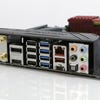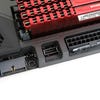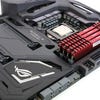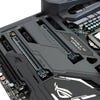Intel Kaby Lake: Core i5 7600K review
It's the fastest i5 yet - but is that enough?
The reality of microprocessor design is slowly but surely losing pace against Moore's Law - and Intel's new Kaby Lake series of CPUs is a clear example of this. Stuck on the 14nm fabrication process, the latest Core i5s and i7s offer - clock for clock - the exact same performance as the existing Skylake processors you can buy now. So is there any actual point in Intel releasing these chips?
Well, the reality is that factoring out IPC (instructions per clock), Kaby Lake is indeed a step forward compared to Skylake. And it all starts with that all-important 14nm process technology. Intel says that it has refined it significantly, the end result being that all Kaby Lake processors offer a frequency boost over their Skylake predecessors. So, in the case of the Core i5 7600K we're reviewing here, base and turbo clocks receive a significant uplift - run the chip on a Z170 or Z270 board, hit the XMP button in the BIOS and you'll have a processor running at 4.2GHz on all four cores with zero effort required. 'Enhanced Turbo' is part and parcel of XMP memory overclocking on all enthusiast boards these days.
The revised CPU manufacturing process also seems to offer significantly higher overclocking potential. Our Skylake-based Core i5 6600K overclocks nicely enough to 4.5GHz, but the new Kaby Lake chip offers rock-solid stability at 4.8GHz with the possibility of hitting over 5.0GHz with air-cooling. We only had an engineering sample chip to test with a pre-retail BIOS before Christmas, but during the holidays, Asus released a new BIOS said to hit offer a one-button 5.0GHz solution that works with 80 per cent of Kaby Lake processors.
Everything else surrounding the main processor cores is upgraded too - next-gen video codecs such as HEVC and Google's VP9 get full hardware support via fixed function media blocks, while the integrated Intel 630 graphics processor also sees a significant uplift (though it's still relatively feeble - for the purposes of an enthusiast gamer pairing the chip with a dedicated GPU, it remains mostly irrelevant here). There's also a new chipset too - Z270 and its non-overclocking equivalent, H270. Upgrades over the Skylake equivalents are relatively thin on the ground - there's support for Intel's next-gen Optane memory/storage system, and four additional PCI Express lanes for more storage connection functionality.
- Buy the Intel Core i5 7600K from Amazon with free shipping.
We were sent an engineering sample Core i5 7600K for review, and we paired this with an Asus Maximus 9 Code Z270 board, and four sticks of Corsair DDR4 rated at 3000MHz with 15-17-17-35 latency. Samples arrived late in the day in 2016, so testing of alternative CPUs was limited - we chose the last-gen Core i5 6600K in order to see what form the generational leap - if any - would take. We also returned to the Core i5 2500K, paired with 2133MHz DDR3, the sticks with the highest bandwidth allowed on the old Sandy Bridge platform. We chose this processor owing to its standing as an enthusiasts' favourite.
In testing, we ran the i5 7600K in three different configurations - at stock speeds with XMP active (in order to access the higher, rated memory bandwidth) and also with the Asus auto-turbo enabled. In theory, with XMP active, all cores will run at the single-core max turbo speed - in this case, 4.2GHz. Our max, rock-solid overclock on the 7600K was 4.8GHz so those results are included too. For the i5 6600K and 2500K, we benched at stock speeds (3.5GHz and 3.3GHz respectively) and also standardised overclocking at 4.2GHz in order to ascertain clock-for-clock relationships between all three processors.
To begin with, we ran some basic benchmarks - Intel's own extreme tuning utility (XTU), Cinebench R15 for single and multi-core testing and we also ran software video encoding tool, Handbrake. For this test, we used our own Rise of the Tomb Raider 4K60 video (available from digitalfoundry.net) and re-encoded it using both h.264 and HEVC. That proved... lengthy.
| Core i5 7600K Stock | Core i5 7600K 4.2GHz | Core i5 7600K 4.8GHz | Core i5 6600K Stock | Core i5 6600K 4.2GHz | Core i5 2500K Stock | Core i5 2500K 4.2GHz | |
|---|---|---|---|---|---|---|---|
| XTU Benchmark | 1244 | 1288 | 1394 | 1142 | 1281 | 665 | 793 |
| Cinebench R15 Single-Core | 173 | 181 | 203 | 150 | 173 | 110 | 145 |
| Cinebench R15 Multi-Core | 654 | 694 | 774 | 562 | 686 | 425 | 544 |
| Handbrake 0.10.5 x264 | 9.4fps | 9.8fps | 11.5fps | 7.3fps | 10.0fps | 5.5fps | 6.9fps |
| Handbrake 0.10.5 x265/HEVC | 4.8fps | 5.2fps | 5.8fps | 3.7fps | 5.1fps | 2.0fps | 2.8fps |
The results confirm that in terms of pure performance on a clock-for-clock basis, Kaby Lake is essentially identical to Skylake, but there is a performance boost from the extra stock clocks. The extent to which performance is improved over vintage 2011 Sandy Bridge processor varies according to the benchmark - at best, in the x265/HEVC test, we're looking at an 85 per cent improvement, but improvements elsewhere are as low as 27 per cent. It demonstrates that synthetic benchmarks have little value, but the video encoding tests are enlightening. A processor's capabilities aren't defined by instructions per clock performance alone - over the year, new instructions are added to CPU architectures and with Handbrake's x265 HEVC encoder, we seem to see those additional capabilities fully put to the test.
But it's gaming that we're primarily interested in, which presents an interesting challenge. Most games are mostly limited by the graphics card, to the point where isolating areas where you are CPU-bound is a challenge. Our solution is to run titles at 1080p on max settings, paired with an overclocked Titan X Pascal. This propels the CPU to the forefront as the primary limiting factor. It's worth stressing that these benchmarks are not supposed to be indicative of the gaming experience - they are simply the means by which relative processor performance can be ascertained when running gaming tasks.
We've included some of our GPU tests here, but for the most part, we've tried to tweak things in order to put more stress on the CPU. Rise of the Tomb Raider's geothermal valley has a big CPU requirement, so we're a score attack run-through there as opposed to the game's standard benchmark. We've relocated the Crysis 3 benchmark in order to hit CPU harder in the Welcome to the Jungle stage, but most of our other GPU tests can be repurposed to test processor performance instead. For example, our Assassin's Creed Unity and Witcher 3 runs can max out a modern i5 fairly easily, while - remarkably - the Far Cry engine is a great workout for CPU speed, threads and even processor cache. Meanwhile, Ashes of the Singularity ships with a CPU stress test which we've tapped into for our tests. The results below are averages: lowest recorded frame-rates can be anything up to half what you're seeing here.
| 1080p/Titan X Pascal OC | Core i5 7600K Stock | Core i5 7600K 4.2GHz | Core i5 7600K 4.8GHz | Core i5 6600K Stock | Core i5 6600K 4.2GHz | Core i5 2500K Stock | Core i5 2500K 4.2GHz |
|---|---|---|---|---|---|---|---|
| Assassin's Creed Unity, Ultra High, FXAA | 121.4 | 124.4 | 125.4 | 117.0 | 122.9 | 75.8 | 96.7 |
| Ashes of the Singularity, DX12, CPU Test | 29.6 | 29.8 | 33.1 | 26.2 | 29.9 | 17.2 | 23.2 |
| Crysis 3, Very High, SMAA T2x | 99.4 | 100.8 | 108.6 | 93.4 | 100.5 | 66.6 | 83.7 |
| The Division, Ultra, SMAA | 132.0 | 134.2 | 134.6 | 132.4 | 133.3 | 111.2 | 123.7 |
| Far Cry Primal, Ultra, SMAA | 117.2 | 124.0 | 137.4 | 111.8 | 123.9 | 70.8 | 92.7 |
| Rise of the Tomb Raider DX12, Very High, SMAA | 89.7 | 93.3 | 97.8 | 83.1 | 93.4 | 57.4 | 69.7 |
| The Witcher 3, Ultra, No Hairworks | 99.0 | 109.2 | 114.9 | 97.7 | 108.5 | 62.6 | 81.7 |
Clock-for-clock, with all processors equalised to 4.2GHz, Skylake and Kaby Lake offer an average improvement of around 30 per cent in terms of gaming frame-rates - and this extends to lowest recorded frame-rates too, where the difference is most keenly felt. The Core i5 2500K still does a reasonable job overall, but if you are holding onto this processor, or its 3570K successor, we strongly recommend reading our guide on how to get the most out of your Sandy Bridge or Ivy Bridge system. To cut a lot story short - processor performance scales in line with memory bandwidth, so gains with a modern i5 may actually be much, much higher - combine that with higher overclocking or an upgrade to an i7 and there may be life in your system yet.
For gaming, Kaby Lake may show no discernable upgrade over Skylake in equalised clock scenarios, but clearly the extra stock clocks are going to be very useful, particularly if you choose to plump for a non-K Intel processor. Both the Core i5 6400 and i5 6500 gained a strong following owing to their cheaper prices and decent gaming frame-rates, the latter in particular offering a creditable balance of price vs performance. Kaby Lake offers more than a frequency boost too - on non-Z boards, it's possible to utilise 2400MHz DDR4 as opposed to the rock-bottom 2133MHz modules. This is significant in CPU-bound gaming scenarios.
To illustrate the relationship between memory bandwidth and processor performance, we re-ran all of our gaming benchmarks with the Core i5 7600K running at stock clocks and overclocked to 4.8GHz. We ran each title with our Corsair modules running at 2133MHz, 2400MHz and their max rated 3000MHz. The results can be remarkable. An overclocked i5 running at 4.8GHz with 2133MHz modules can be beaten in some scenarios by the i5 running at stock speeds with 300MHz DDR4. And let's remember that 3000MHz DDR4 is no longer the limit - overclocked modules are now hitting 4200MHz.
| 1080p/Titan X Pascal OC | Core i5 7600K Stock | Core i5 7600K Stock | Core i5 7600K Stock | Core i5 7600K 4.8GHz | Core i5 7600K 4.8GHz | Core i5 7600K 4.8GHz |
|---|---|---|---|---|---|---|
| DDR4 Clock Speed | 3000MHz | 2400MHz | 2133MHz | 3000MHz | 2400MHz | 2133MHz |
| Assassin's Creed Unity, Ultra High, FXAA | 121.4 | 113.0 | 107.7 | 125.4 | 119.4 | 110.9 |
| Ashes of the Singularity, DX12, CPU Test | 29.6 | 27.7 | 26.5 | 33.1 | 31.3 | 30.3 |
| Crysis 3, Very High, SMAA T2x | 99.4 | 98.8 | 98.5 | 108.6 | 108.0 | 105.0 |
| The Division, Ultra, SMAA | 132.0 | 130.4 | 130.4 | 134.6 | 133.0 | 131.7 |
| Far Cry Primal, Ultra, SMAA | 117.2 | 103.7 | 98.2 | 137.4 | 122.8 | 121.2 |
| Rise of the Tomb Raider DX12, Very High, SMAA | 89.7 | 85.7 | 81.0 | 97.8 | 93.6 | 88.2 |
| The Witcher 3, Ultra, No Hairworks | 97.7 | 92.4 | 85.9 | 114.9 | 99.2 | 95.1 |
It stands to reason really - graphics cards tend to scale compute power with memory bandwidth, so why shouldn't CPUs benefit too? We've seen similar relationships on all of our CPU tests going back to Sandy Bridge, so this is not anything new. The bottom line is that getting the most out of your overclock rests not only on boosting frequency but by scaling memory bandwidth too. We would also expect tighter RAM latencies to yield additional, smaller scale performance boosts too.
There are wider implications for this beyond the Core i5 7600K we're testing here. Locked Intel processors will also benefit from higher memory bandwidth, but anything higher than 2133MHz frequencies are not possible on existing Skylake-based motherboards. Kaby Lake introduces support for 2400MHz DDR4, which should extent to lower-end boards. So not only will we see a frequency boost to the processor itself, but the chip should produce better gaming performance if paired with faster memory.
In terms of overclocking the i5, it was simplicity itself to get the system to boot at 5.2GHz. However, a Prime95 stress test saw heat kick in massively with hardware errors quickly manifesting. We settled a 48 multiplier, giving us a rock solid 4.8GHz and temperatures in the 70-75 celsius range once we'd adjusted voltage accordingly. However, we should stress that this was achieved with an engineering sample and with an older, pre-release BIOS. We've heard enthusiast desktop systems will ship with Kaby Lake chips at 4.8GHz, suggesting that there is more in the tank on the majority of overclockable K processors. However, equally, initial tests on the i7 7700K are showing similar results - we can easily boot this CPU at over 5GHz, but excessive heat seems to be an issue. We'll report back on this in more depth when review the i7 with a more mature BIOS, but the bottom line is clear - you should be able to easily achieve higher overclocks with Kaby Lake - we've tested two Skylake i5 6600Ks and both of them topped out at 4.5GHz.
So how does all of this benchmark data relate to the gameplay experience? Typically, frame-rates are limited by your graphics card's capabilities, or an arbitrary frame-rate cap (v-sync will typically lock you to 60fps). It's dips below that can be caused by lack of CPU power, and these performance drops generally take the form of uneven stutter. Using a monitoring tool like Riva Tuner Statistics Server is typically the best way to see if you are CPU bound, as it's possible to monitor per-core load there. Our general feeling is that the veteran Sandy Bridge and Ivy Bridge processors are due an upgrade, but staying on those existing boards and going for an overclockable i7 paired with fast RAM can still keep you in the game - for now.
Intel Kaby Lake Core i5 7600K - the Digital Foundry verdict
With Intel's tick-tock strategy for new products now a thing of the past, Kaby Lake offers the customary minimal year-on-year bump in performance via higher clock-speeds as opposed to any architectural improvements. There's no increase in gaming performance on a clock-for-clock level, but a 4.8GHz to 5GHz overclock with air-cooling may be interesting enough to keep enthusiasts looking to upgrade on board. The latest generation Core i5 K-chip you can buy has offered the sweetspot in terms of price, performance and system longevity for over five years now and based on those aspects, the Core i5 7600K is no different.
However, with AMD's new Ryzen CPU products arriving this year, many may be tempted to wait to see what the competition has to offer. However, the question is when we will see a mainstream offering based on AMD's new architecture. As things stand, everything AMD has demoed thus far has seen Ryzen compared against Intel's top-tier eight-core enthusiast line, as opposed to the gaming staple that is the Core i5. CES may prove forthcoming, but it may well be the case that we'll see a top-down approach from AMD, tackling the more lucrative enthusiast line before moving down to more mainstream markets.
Until then, the i5's closest competition is likely to be its own Core i7 line - whether you're picking up the latest Kaby Lake chip, an existing Skylake processor or even an older chip. We do have the Core i7 3770K, 4790K and 6700K in-house and we'll be testing them up against the brand new 7700K as soon as we can.
